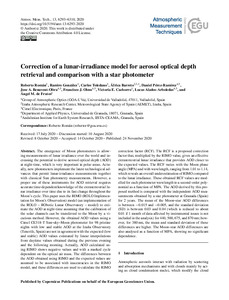Por favor, use este identificador para citar o enlazar este ítem:
http://hdl.handle.net/20.500.11765/12592
Correction of a lunar-irradiance model for aerosol optical depth retrieval and comparison with a star photometer
Registro completo de metadatos
| Campo DC | Valor | Lengua/Idioma |
|---|---|---|
| dc.contributor.author | Román, Roberto | es_ES |
| dc.contributor.author | González, Ramiro | es_ES |
| dc.contributor.author | Toledano, Carlos | es_ES |
| dc.contributor.author | Barreto Velasco, África | es_ES |
| dc.contributor.author | Pérez Ramírez, Daniel | es_ES |
| dc.contributor.author | Benavent Oltra, José Antonio | es_ES |
| dc.contributor.author | Olmo Reyes, Francisco José | es_ES |
| dc.contributor.author | Cachorro, Victoria E. | es_ES |
| dc.contributor.author | Alados Arboledas, Lucas | es_ES |
| dc.contributor.author | Frutos Baraja, Ángel Máximo de | es_ES |
| dc.date.accessioned | 2020-11-30T09:20:11Z | - |
| dc.date.available | 2020-11-30T09:20:11Z | - |
| dc.date.issued | 2020 | - |
| dc.identifier.citation | Atmospheric Measurement Techniques. 2020, 13(11), p. 6293–6310 | es_ES |
| dc.identifier.issn | 1867-1381 | - |
| dc.identifier.issn | 1867-8548 | - |
| dc.identifier.uri | http://hdl.handle.net/20.500.11765/12592 | - |
| dc.description.abstract | The emergence of Moon photometers is allowing measurements of lunar irradiance over the world and increasing the potential to derive aerosol optical depth (AOD) at night-time, which is very important in polar areas. Actually, new photometers implement the latest technological advances that permit lunar-irradiance measurements together with classical Sun photometry measurements. However, a proper use of these instruments for AOD retrieval requires accurate time-dependent knowledge of the extraterrestrial lunar irradiance over time due to its fast change throughout the Moon's cycle. This paper uses the RIMO (ROLO Implementation for Moon's Observation) model (an implementation of the ROLO – RObotic Lunar Observatory – model) to estimate the AOD at night-time assuming that the calibration of the solar channels can be transferred to the Moon by a vicarious method. However, the obtained AOD values using a Cimel CE318-T Sun–sky–Moon photometer for 98 pristine nights with low and stable AOD at the Izaña Observatory (Tenerife, Spain) are not in agreement with the expected (low and stable) AOD values estimated by linear interpolations from daytime values obtained during the previous evening and the following morning. Actually, AOD calculated using RIMO shows negative values and with a marked cycle dependent on the optical air mass. The differences between the AOD obtained using RIMO and the expected values are assumed to be associated with inaccuracies in the RIMO model, and these differences are used to calculate the RIMO correction factor (RCF). The RCF is a proposed correction factor that, multiplied by the RIMO value, gives an effective extraterrestrial lunar irradiance that provides AOD closer to the expected values. The RCF varies with the Moon phase angle (MPA) and with wavelength, ranging from 1.01 to 1.14, which reveals an overall underestimation of RIMO compared to the lunar irradiance. These obtained RCF values are modelled for each photometer wavelength to a second-order polynomial as a function of MPA. The AOD derived by this proposed method is compared with the independent AOD measurements obtained by a star photometer at Granada (Spain) for 2 years. The mean of the Moon–star AOD differences is between −0.015 and −0.005, and the standard deviation (SD) is between 0.03 and 0.04 (which is reduced to about 0.01 if 1 month of data affected by instrumental issues is not included in the analysis) for 440, 500, 675, and 870 nm; however, for 380 nm, the mean and standard deviation of these differences are higher. The Moon–star AOD differences are also analysed as a function of MPA, showing no significant dependence. | es_ES |
| dc.description.sponsorship | This research has been supported by the Spanish Ministry of Science, Innovation and Universities (grant no. RTI2018-097864-b-I00); the Spanish Ministry of Economy and Competitiveness (grant nos. CGL2016-81092-R and CGL2017-90884-REDT); the European Union's Horizon 2020 research and innovation programme (grant no. ACTRIS IMP 871115); and the Andalusia Regional Government (grant no. P18-RT-3820). | es_ES |
| dc.language.iso | eng | es_ES |
| dc.publisher | European Geosciences Union | es_ES |
| dc.rights | Licencia CC: Reconocimiento CC BY | es_ES |
| dc.subject | Photometers | es_ES |
| dc.subject | Lunar irradiance | es_ES |
| dc.subject | Aerosol optical depth | es_ES |
| dc.subject | RIMO | es_ES |
| dc.title | Correction of a lunar-irradiance model for aerosol optical depth retrieval and comparison with a star photometer | es_ES |
| dc.type | info:eu-repo/semantics/article | es_ES |
| dc.relation.publisherversion | https://dx.doi.org/10.5194/amt-13-6293-2020 | es_ES |
| dc.rights.accessRights | info:eu-repo/semantics/openAccess | es_ES |
| dc.relation.projectID | info:eu-repo/grantAgreement/EC/H2020/871115 | es_ES |
| Colecciones: | Artículos científicos 2019-2022 | |
Ficheros en este ítem:
| Fichero | Descripción | Tamaño | Formato | ||
|---|---|---|---|---|---|
| amt-13-6293-2020.pdf | 4,6 MB | Adobe PDF |  Visualizar/Abrir |
Los ítems de Arcimis están protegidos por una Licencia Creative Commons, salvo que se indique lo contrario.





